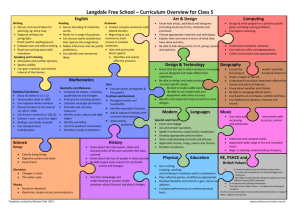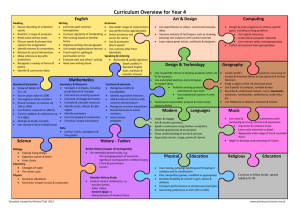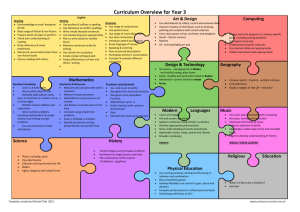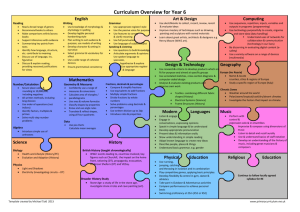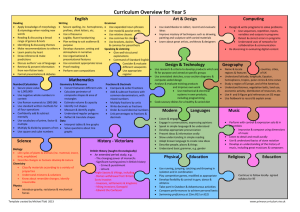Maths Key Objectives
advertisement
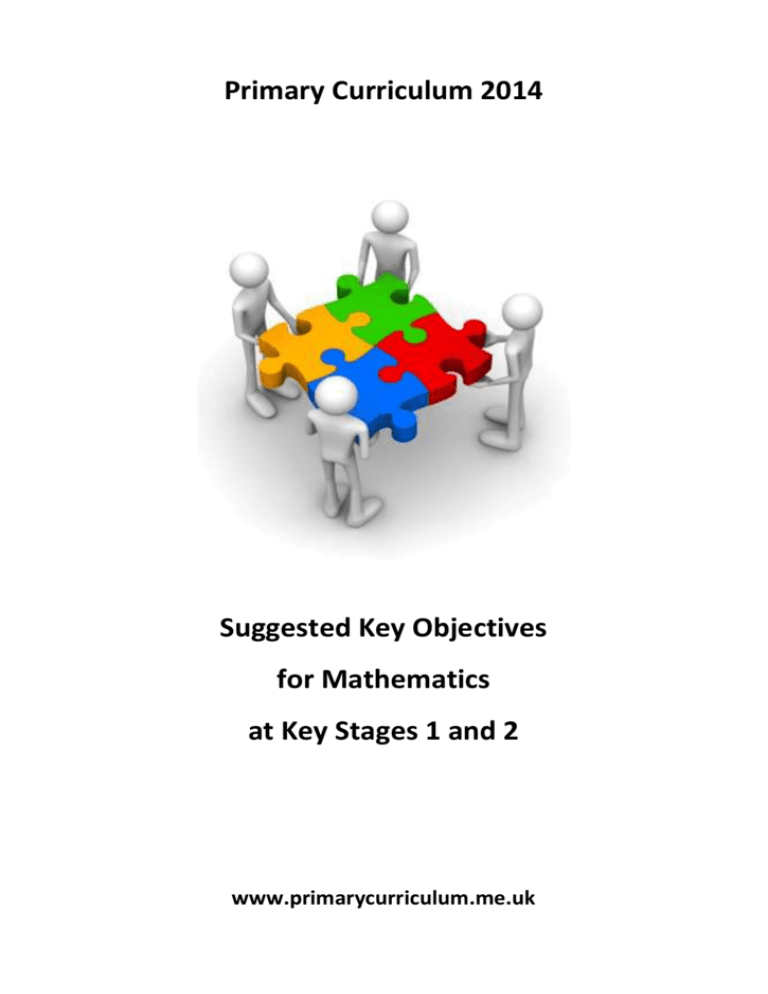
Primary Curriculum 2014 Suggested Key Objectives for Mathematics at Key Stages 1 and 2 www.primarycurriculum.me.uk Year 1 Maths Key Objectives Taken from the National Curriculum 1 Count to and across 100, forwards and backwards, beginning with 0 or 1, or from any given number 2 Count, read and write numbers to 100 in numerals 3 Read, write and interpret mathematical statements involving addition (+), subtraction (–) and equals (=) signs 4 Given a number, identify one more and one less 5 Represent and use number bonds and related subtraction facts within 20 6 Add and subtract one-digit and two-digit numbers to 20, including zero 7 Recognise, find and name a half as one of two equal parts of an object, shape or quantity 8 Recognise, find and name a quarter as one of four equal parts of an object, shape or quantity. 9 Measure and begin to record length/height, weight/mass, capacity/volume & time 10 Recognise and know the value of different denominations of coins and notes 11 Sequence events in chronological order using language 12 Recognise and use language relating to dates, including days of the week, weeks, months and years 13 Tell the time to the hour and half past the hour and draw the hands on a clock face to show these times 14 Recognise and name common 2-D shapes (e.g. Square, circle, triangle) 15 Recognise and name common 3-D shapes (e.g. Cubes, cuboids, pyramids & spheres) The objectives from the National Curriculum are used under Open Government Licence/ Summarised statements are provided under a Creative Commons Attribution-NonCommercial 3.0 Unported License. Michael Tidd, 2014 Year 1 Maths Key Objectives Summarised form 1 Count to and across 100 from any number 2 Count, read and write numbers to 100 in numerals 3 Read and write mathematical symbols: +, - and = 4 Identify "one more" and "one less" 5 Use number bonds and subtraction facts within 20 6 Add and subtract 1-digit and 2-digit numbers to 20, including zero 7 Recognise, find and name a half 8 Recognise, find and name a quarter 9 Measure and begin to record length, mass, volume and time 10 Recognise and know the value of all coins and notes 11 Use language to sequence events in chronological order 12 Recognise and use language relating to dates 13 Tell the time to the half-hour, including drawing clocks 14 Recognise and name common 2-D shapes 15 Recognise and name common 3-D shapes The objectives from the National Curriculum are used under Open Government Licence/ Summarised statements are provided under a Creative Commons Attribution-NonCommercial 3.0 Unported License. Michael Tidd, 2014 Year 2 Maths Key Objectives Taken from the National Curriculum 1 Count in steps of 2, 3, and 5 from 0, and in tens from any number, forward and backward 2 Recognise the place value of each digit in a two-digit number 3 Compare and order numbers from 0 up to 100; use <, > and = signs 4 5 6 7 8 9 Use place value and number facts to solve problems; recall and use addition and subtraction facts to 20 fluently, and derive and use related facts up to 100 Add and subtract numbers using concrete objects, pictorial representations, and mentally, including: TU+U, TU+T, TU+TU and U+U+U Recognise and use the inverse relationship between addition and subtraction and use this to check calculations and solve missing number problems. Recall and use multiplication and division facts for the 2, 5 and 10 multiplication tables, including recognising odd and even numbers Calculate mathematical statements for multiplication and division within the multiplication tables and write them using the multiplication (×), division (÷) and equals (=) signs Recognise, find, name and write fractions 1/3, 1/4 , 2/4 and 3/4 of a length, shape, set of objects or quantity 10 Write simple fractions for example, 1/2 of 6 = 3 and recognise the equivalence of 2/4 and 1/2. 11 Recognise and use symbols for pounds (£) and pence (p); combine amounts to make a particular value 13 Tell and write the time to five minutes, including quarter past/to the hour and draw the hands on a clock face to show these times Identify and describe the properties of 2-D shapes, including the number of sides and line symmetry in a vertical line. 14 Identify and describe the properties of 3-D shapes, including the number of edges, vertices and faces 15 Interpret and construct simple pictograms, tally charts, block diagrams and simple tables 12 The objectives from the National Curriculum are used under Open Government Licence/ Summarised statements are provided under a Creative Commons Attribution-NonCommercial 3.0 Unported License. Michael Tidd, 2014 Year 2 Maths Key Objectives Summarised form 1 Count in steps of 2s, 3s and 5s, and steps of 10 2 Recognise place value in two-digit numbers 3 Compare and order numbers up to 100 using <, > and = 4 Recall and use number addition/subtraction facts to 20, and derive related facts 5 Add and subtract mentally and with objects one- and two-digit numbers 6 Understand and use the inverse relationship between addition and subtraction 7 Know 2×, 5× and 10× tables, including recognising odd & even numbers 8 Calculate mathematical statements using x and ÷ symbols 9 Recognise, find, name and write 1/3, 1/4, 1/2 and 3/4 of size, shape or quantity 10 Write simple fraction facts, e.g. 1/2 of 6 = 3 11 Combine amounts of money to make a value, including using £ and p symbols 12 Tell the time to the nearest 5 minutes, including drawing clocks 13 Describe properties of 2-D shapes, including number of sides and symmetry 14 Describe properties of 3-D shapes, including number of edges, vertices and faces 15 Interpret and construct simple tables, tally charts and pictograms The objectives from the National Curriculum are used under Open Government Licence/ Summarised statements are provided under a Creative Commons Attribution-NonCommercial 3.0 Unported License. Michael Tidd, 2014 Year 3 Maths Key Objectives Taken from the National Curriculum 1 Count from 0 in multiples of 4, 8, 50 and 100; find 10 or 100 more or less than a given number. 2 Compare and order numbers up to 1000 3 Add and subtract numbers mentally, including: HTU+U, HTU+T and HTU+H 4 Add and subtract numbers with up to three digits, using formal written methods of columnar addition and subtraction 5 Estimate the answer to a calculation and use inverse operations to check answers 6 Recall and use multiplication and division facts for the 3, 4 and 8 multiplication tables 7 Count up and down in tenths; 8 Recognise that tenths arise from dividing an object into 10 equal parts and in dividing one-digit numbers or quantities by 10 9 Compare and order unit fractions, and fractions with the same denominators 10 Recognise and show, using diagrams, equivalent fractions with small denominators 11 Recognise, find and write fractions of a discrete set of objects: unit fractions and non-unit fractions with small denominators 12 Add and subtract fractions with the same denominator within one whole [for example, 5/7 + 1/7 = 6/7 ] 13 Measure, compare, add and subtract: lengths (m/cm/mm); mass (kg/g); volume/capacity (l/ml) 14 Measure the perimeter of simple 2-D shapes 15 Add and subtract amounts of money to give change, using both £ and p in practical contexts 16 Tell and write the time from an analogue clock, including using Roman numerals from I to XII, and 12hour and 24-hour clocks 17 Estimate and read time with increasing accuracy to the nearest minute 18 Identify horizontal and vertical lines and pairs of perpendicular and parallel lines 19 Identify whether angles are greater or less than a right angle 20 Interpret and present data using bar charts, pictograms and tables The objectives from the National Curriculum are used under Open Government Licence/ Summarised statements are provided under a Creative Commons Attribution-NonCommercial 3.0 Unported License. Michael Tidd, 2014 Year 3 Maths Key Objectives Summarised form 1 Count in multiples of 4, 8, 50 and 100 2 Compare and order numbers up to 1000 3 Add and subtract numbers mentally, including round numbers to HTU 4 Add and subtract using standard column method 5 Estimate answers to calculations and use the inverse to check answers 6 Know 3×, 4× and 8× tables 7 Count up and down in tenths 8 Understand that tenths are objectives or quantities divided into ten equal parts 9 Compare and order simple fractions 10 Recognise and show equivalent fractions 11 Find and write fractions of a set of objects 12 Add and subtract fractions with common denominators (less than one) 13 Measure, compare and calculate measures using standard units 14 Measure the perimeter of simple 2-D shapes 15 Add and subtract money, including giving change 16 Tell and write the time from an analogue clock, including using Roman numerals 17 Estimate and read time to the nearest minute 18 Identify horizontal, vertical, parallel and perpendicular lines 19 Identify whether angles are greater or less than a right angle 20 Interpret and present data using bar charts, pictograms and tables The objectives from the National Curriculum are used under Open Government Licence/ Summarised statements are provided under a Creative Commons Attribution-NonCommercial 3.0 Unported License. Michael Tidd, 2014 Year 4 Maths Key Objectives Taken from the National Curriculum 1 Count backwards through zero to include negative numbers 2 Recognise the place value of each digit in a four-digit number 3 Round any number to the nearest 10, 100 or 1000 4 Recall multiplication and division facts for multiplication tables up to 12 × 12 5 Use place value, known and derived facts to multiply and divide mentally, including: multiplying by 0 and 1; dividing by 1; multiplying together three numbers 6 Recognise and use factor pairs and commutativity in mental calculations 7 Multiply two-digit and three-digit numbers by a one-digit number using formal written layout 8 Recognise that hundredths arise when dividing an object by one hundred and dividing tenths by ten. 9 Recognise and write decimal equivalents to ¼, ½ and ¾ 10 Find the effect of dividing a one- or two-digit number by 10 and 100, identifying the value of the digits in the answer as ones, tenths and hundredths 11 Round decimals with one decimal place to the nearest whole number 12 Compare numbers with the same number of decimal places up to two decimal places 13 Convert between different units of measure; estimate, compare and calculate different measures, including money in pounds and pence 14 Find the area of rectilinear shapes by counting squares 16 Solve problems involving converting from hours to minutes; minutes to seconds; years to months; weeks to days Compare and classify geometric shapes, including quadrilaterals and triangles, based on properties and sizes 17 Complete a simple symmetric figure with respect to a specific line of symmetry. 18 Describe positions on a 2-D grid as coordinates in the first quadrant 19 Describe movements between positions as translations of a given unit to the left/right and up/down 20 Interpret and present discrete and continuous data using appropriate graphical methods, including bar charts and time graphs 15 The objectives from the National Curriculum are used under Open Government Licence/ Summarised statements are provided under a Creative Commons Attribution-NonCommercial 3.0 Unported License. Michael Tidd, 2014 Year 4 Maths Key Objectives Summarised form 1 Count backwards through zero, including negative numbers 2 Recognise place value in four-digit numbers 3 Round any number to the nearest 10, 100 or 1000 4 Know tables up to 12 × 12 5 Use place value and number facts to carry out mental calculations 6 Use factor pairs and commutativity in mental calculations 7 Use short multiplication method 8 Recognise and use hundredths 9 Recognise and write decimal equivalents to ¼, ½ and ¾ 10 Divide one- or two-digit numbers by 10 and 100, using tenths and hundredths 11 Round decimals with one decimal place to the nearest whole number 12 Compare numbers up to two decimal places 13 Convert between different units of metric measurement, including money 14 Find the area of rectilinear shapes by counting squares 15 Solve problems converting units of time 16 Compare and classify shapes, including quadrilaterals and triangles 17 Complete a simple symmetric figure with respect to a specific line of symmetry. 18 Describe positions on a 2-D grid using co-ordinates 19 Describe translations using a given unit to the left/right and up/down 20 Interpret and present discrete and continuous data on appropriate graphs The objectives from the National Curriculum are used under Open Government Licence/ Summarised statements are provided under a Creative Commons Attribution-NonCommercial 3.0 Unported License. Michael Tidd, 2014 Year 5 Maths Key Objectives Taken from the National Curriculum 1 2 3 4 5 6 7 8 9 10 11 12 13 14 15 16 17 18 19 20 21 22 23 24 25 26 27 28 29 30 Interpret negative numbers in context, count forwards and backwards with positive and negative whole numbers, including through zero Read Roman numerals to 1000 (M) and recognise years written in Roman numerals Recognise and use square numbers and cube numbers, and the notation for squared (²) and cubed (³) Use rounding to check answers to calculations and determine, in the context of a problem, levels of accuracy Identify multiples and factors, including finding all factor pairs of a number, and common factors of two numbers Know and use the vocabulary of prime numbers, prime factors and composite (non-prime) numbers Establish whether a number up to 100 is prime and recall prime numbers up to 19 Multiply and divide whole numbers and those involving decimals by 10, 100 and 1000 Multiply numbers up to 4 digits by a one- or two-digit number using a formal written method, including long multiplication for two-digit numbers Divide numbers up to 4 digits by a one-digit number using the formal written method of short division and interpret remainders appropriately for the context Recognise mixed numbers and improper fractions and convert from one form to the other and write mathematical statements > 1 as a mixed number Compare and order fractions whose denominators are all multiples of the same number Identify, name and write equivalent fractions of a given fraction, represented visually, including tenths and hundredths Add and subtract fractions with the same denominator and denominators that are multiples of the same number Multiply proper fractions and mixed numbers by whole numbers, supported by materials and diagrams Read and write decimal numbers as fractions Round decimals with two decimal places to the nearest whole number and to one decimal place Read, write, order and compare numbers with up to three decimal places Recognise the per cent symbol (%) and understand that per cent relates to ‘number of parts per hundred’, and write percentages as a fraction with denominator 100, and as a decimal Understand and use approximate equivalences between metric units and common imperial units such as inches, pounds and pints Measure and calculate the perimeter of composite rectilinear shapes in centimetres and metres Calculate and compare the area of rectangles (including squares), and including using standard units, square centimetres (cm²) and square metres (m²) and estimate the area of irregular shapes Use the properties of rectangles to deduce related facts and find missing lengths and angles Distinguish between regular and irregular polygons based on reasoning about equal sides and angles. Identify 3-D shapes, including cubes and other cuboids, from 2-D representations Know angles are measured in degrees: estimate and compare acute, obtuse and reflex angles Draw given angles, and measure them in degrees (°) Identify angles at a point and one whole turn (total 360°); at a point on a straight line and ½ a turn (total 180°) Identify, describe and represent the position of a shape following a reflection or translation, using the appropriate language, and know that the shape has not changed Complete, read and interpret information in tables, including timetables The objectives from the National Curriculum are used under Open Government Licence/ Summarised statements are provided under a Creative Commons Attribution-NonCommercial 3.0 Unported License. Michael Tidd, 2014 Year 5 Maths Key Objectives Summarised form 1 Interpret negative numbers in context 2 Read Roman numerals to 1000, including years 3 Recognise and use square and cube numbers, and know the notation 4 Use rounding to check answers and determine accuracy 5 Identify multiples and factors, including finding factor pairs and common factors 6 Use vocabulary: prime numbers, prime factors and composite numbers 7 Know prime numbers up to 19 8 Multiply and divide numbers by 10, 100 or 1000, including decimals 9 Use long multiplication for multiplying numbers of up to 4 digits by one or two digits 10 Divide numbers using standard written short division 11 Convert between mixed numbers and improper fractions 12 Compare and order fractions whose denominators are multiples of the same number 13 Identify, name and write equivalent fractions including tenths and hundredths 14 Add and subtract fractions with denominators that are multiples of the same number 15 Multiply proper fractions and mixed numbers by whole numbers with support 16 Read and write decimal numbers as fractions 17 Round decimals with 2 decimals places to whole number or to one decimal place 18 Read, write, order and compare numbers with up to 3 decimal places 19 Recognise % symbol and explain as a fraction with denominator 100 (parts out of 100) 20 Understand and use common approximate conversions between metric and imperial 21 Measure and calculate the perimeter of composite rectilinear shapes 22 Calculate the area of rectangles, and estimate the area of irregular shapes 23 Use the properties of rectangles to find missing lengths and angles 24 Distinguish between regular and irregular polygons 25 Identify 3-d shapes from 2-d representations 26 Know angles are measured in degrees and compare acute, obtuse and reflex angles 27 Draw and measure angles to the nearest degree 28 Identify angles at a point, in a turn and on a straight line 29 Describe and represent the result of a reflection or translation 30 Complete, read and interpret information in tables, including timetables The objectives from the National Curriculum are used under Open Government Licence/ Summarised statements are provided under a Creative Commons Attribution-NonCommercial 3.0 Unported License. Michael Tidd, 2014 Year 6 Maths Key Objectives Taken from the National Curriculum 1 2 3 4 5 6 7 8 9 10 11 12 13 14 15 16 17 18 19 20 21 22 23 24 25 26 27 28 29 30 Use negative numbers in context, and calculate intervals across zero Divide numbers up to 4 digits by a two-digit whole number using the formal written method of long division, and interpret remainders as whole number remainders, fractions, or by rounding, as appropriate for the context Use their knowledge of the order of operations to carry out calculations involving the four operations Use common factors to simplify fractions Compare and order fractions, including fractions > 1 Add and subtract fractions with different denominators and mixed numbers, using the concept of equivalent fractions Multiply simple pairs of proper fractions, writing the answer in its simplest form Divide proper fractions by whole numbers Associate a fraction with division and calculate decimal fraction equivalents [for example, 0.375] for a simple fraction Multiply one-digit number with up to two decimal places by whole numbers Use written division methods in cases where the answer has up to two decimal places Solve problems involving the calculation of percentages [for example, of measures, and such as 15% of 360] and the use of percentages for comparison Recall and use equivalences between simple fractions, decimals and percentages, including in different contexts. Solve problems involving the relative sizes of two quantities where missing values can be found by using integer multiplication and division facts Solve problems involving similar shapes where the scale factor is known or can be found Solve problems involving unequal sharing and grouping using knowledge of fractions and multiples. Use simple formulae Generate and describe linear number sequences Express missing number problems algebraically Use, read, write and convert between standard units, converting measurements of length, mass, volume and time from a smaller unit of measure to a larger unit, and vice versa, using decimal notation to up to three decimal places Convert between miles and kilometres Calculate the area of parallelograms and triangles Calculate, estimate and compare volume of cubes and cuboids using standard units Illustrate and name parts of circles, including radius, diameter and circumference and know that the diameter is twice the radius Find unknown angles in any triangles, quadrilaterals, and regular polygons Recognise angles where they meet at a point, are on a straight line, or are vertically opposite, and find missing angles Describe positions on the full coordinate grid (all four quadrants) Draw and translate simple shapes on the coordinate plane, and reflect them in the axes. Interpret and construct pie charts and line graphs Calculate and interpret the mean as an average The objectives from the National Curriculum are used under Open Government Licence/ Summarised statements are provided under a Creative Commons Attribution-NonCommercial 3.0 Unported License. Michael Tidd, 2014 Year 6 Maths Key Objectives Summarised form 1 Use negative numbers to calculate intervals across zero 2 Divide numbers using long division, interpreting the remainders as appropriate 3 Use order of operations to carry out calculations 4 Use common factors to simplify fractions 5 Compare and order fractions of any size 6 Add and subtract fractions with different denominators and mixed numbers 7 Multiply simple pairs of proper fractions 8 Divide proper fractions by whole numbers 9 Calculate decimal fraction equivalents for simple fractions 10 Multiply a number with up to two decimal places by whole numbers 11 Use written division with answers of up to two decimal places 12 Solve problems involving the calculation of percentages 13 Recall and use equivalences between fractions, decimals and percentages 14 Solve problems using ratio using multiplication and division facts 15 Solve problems involving similar shapes where the scale factor is known 16 Solve problems involving proportion, using knowledge of fractions and multiples 17 Use simple formulae 18 Generate and describe linear number sequences 19 Express missing number problems algebraically 20 Convert units of measure between smaller and larger units 21 Convert between miles and kilometres 22 Calculate the area of parallelograms and triangles 23 Calculate and compare volume of cubes and cuboids 24 Illustrate and name parts of a circle 25 Finding missing angles in triangles, quadrilaterals and regular polygons 26 Recognise vertically opposite angles and find missing angles 27 Describe positions on the full co-ordinate grid 28 Translate shapes on a co-ordinate grid and reflect in the axes 29 Construct and interpret pie charts 30 Calculate the mean as an average The objectives from the National Curriculum are used under Open Government Licence/ Summarised statements are provided under a Creative Commons Attribution-NonCommercial 3.0 Unported License. Michael Tidd, 2014 The objectives from the National Curriculum are used under Open Government Licence/ Summarised statements are provided under a Creative Commons Attribution-NonCommercial 3.0 Unported License. Michael Tidd, 2014

